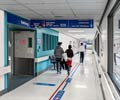A new study led by De Montfort University has found that patients recovering from surgery get infections far more often than is being reported.

They say a study of the way in which NHS hospital trusts in England has shown "worrying inconsistencies" between hospitals in how they defined surgical site infections and how rigorously they looked for them. As a result, published infection rates for hospitals do not always give a true picture.
The reasons hospitals gave for not submitting data was that the surveillance system was flawed and unwieldy and they didn’t trust the system
Their paper, published today in the Journal of Hospital Infection, casts further doubt on the reliability of the national surgical site infection surveillance scheme in England.
Lead researcher Professor Judith Tanner of De Montfort University said "The national SSI surveillance system in England consistently under-reports the true scale of surgical infection and gives a false sense of security. This study shows there are so many inconsistencies that it’s not possible to benchmark hospitals against the English national surgical site infection data".
Specialists at De Montfort University, Leicester; Southport and Newcastle-upon-Tyne universities sent out a questionnaire to all 156 NHS hospital trusts in England asking how they collected and reported data on post-operative wound infection for the national surgical site infection surveillance scheme. Replies were received from 106 (68%).
Advertisement
The authors suggested that in order to identify the true scale of surgical infections, hospitals should contact every single patient, by letter or phone within 30 days after surgery. Prof Tanner said: "The harder you look, the more that you find. Common sense tells you this and now we have demonstrated that with this study. Perversely, hospitals that conduct robust and high quality surveillance are penalized under the current system".
Advertisement
In 1997, a voluntary surveillance scheme was established allowing hospitals in England to report infections in wound surgical operations. It would enable hospitals to compare their own infection rates against a benchmark, and to use this information to improve the quality of patient care. It is administered and run by the Health Protection Agency.
In 2004, the scheme was extended to make participation in surveillance after orthopaedic surgery mandatory for a minimum of three months a year. In 2008, the scheme was extended to include patients re-admitted to hospital with surgical wound infections.
Surgical infection rates reported by the scheme were however often noticeably lower than rates reported from published research studies. In 2009, after reviewing the scheme, the Public Accounts Committee concluded that the Department of Health did not have an understanding of the true scale of SSIs in England because of a lack of decent data. The scheme continues.
Key findingsThere was non-compliance with the schemes’ protocol and definitions:
- 10% hospitals did not provide data on superficial infections
- 15% did not use the HPA’s standardised definition of wound infection
- There were significant differences in how hard Trusts looked for infection.
- 9/106 hospitals only looked for early infections developing before patients left hospital
- 24/106 hospitals only included patients while they were in hospital, and if they happened to be re-admitted with a wound infection.
- 73/106 hospitals used in-patient, re-admission follow up, and actively looked for infections by directly contacting patients after they had been discharged from hospital (post discharge surveillance)
Source-Eurekalert










